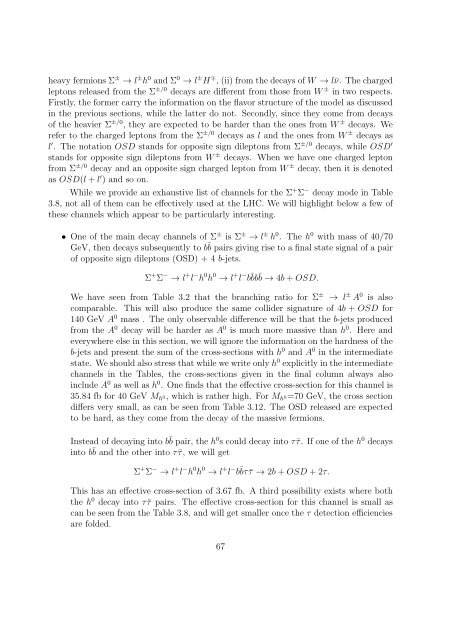PHYS08200604017 Manimala Mitra - Homi Bhabha National Institute
PHYS08200604017 Manimala Mitra - Homi Bhabha National Institute
PHYS08200604017 Manimala Mitra - Homi Bhabha National Institute
You also want an ePaper? Increase the reach of your titles
YUMPU automatically turns print PDFs into web optimized ePapers that Google loves.
heavy fermions Σ ± → l ± h 0 and Σ 0 → l ± H ∓ , (ii) from the decays of W → l¯ν. The charged<br />
leptons released from the Σ ±/0 decays are different from those from W ± in two respects.<br />
Firstly, the former carry the information on the flavor structure of the model as discussed<br />
in the previous sections, while the latter do not. Secondly, since they come from decays<br />
of the heavier Σ ±/0 , they are expected to be harder than the ones from W ± decays. We<br />
refer to the charged leptons from the Σ ±/0 decays as l and the ones from W ± decays as<br />
l ′ . The notation OSD stands for opposite sign dileptons from Σ ±/0 decays, while OSD ′<br />
stands for opposite sign dileptons from W ± decays. When we have one charged lepton<br />
from Σ ±/0 decay and an opposite sign charged lepton from W ± decay, then it is denoted<br />
as OSD(l+l ′ ) and so on.<br />
While we provide an exhaustive list of channels for the Σ + Σ − decay mode in Table<br />
3.8, not all of them can be effectively used at the LHC. We will highlight below a few of<br />
these channels which appear to be particularly interesting.<br />
• One of the main decay channels of Σ ± is Σ ± → l ± h 0 . The h 0 with mass of 40/70<br />
GeV, then decays subsequently to b¯b pairs giving rise to a final state signal of a pair<br />
of opposite sign dileptons (OSD) + 4 b-jets.<br />
Σ + Σ − → l + l − h 0 h 0 → l + l − b¯bb¯b → 4b+OSD.<br />
We have seen from Table 3.2 that the branching ratio for Σ ± → l ± A 0 is also<br />
comparable. This will also produce the same collider signature of 4b + OSD for<br />
140 GeV A 0 mass . The only observable difference will be that the b-jets produced<br />
from the A 0 decay will be harder as A 0 is much more massive than h 0 . Here and<br />
everywhere else in this section, we will ignore the information on the hardness of the<br />
b-jets and present the sum of the cross-sections with h 0 and A 0 in the intermediate<br />
state. Weshouldalsostressthatwhilewewriteonlyh 0 explicitlyintheintermediate<br />
channels in the Tables, the cross-sections given in the final column always also<br />
include A 0 as well as h 0 . One finds that the effective cross-section for this channel is<br />
35.84 fb for 40 GeV M h 0, which is rather high. For M h 0=70 GeV, the cross section<br />
differs very small, as can be seen from Table 3.12. The OSD released are expected<br />
to be hard, as they come from the decay of the massive fermions.<br />
Instead of decaying into b¯b pair, the h 0 s could decay into τ¯τ. If one of the h 0 decays<br />
into b¯b and the other into τ¯τ, we will get<br />
Σ + Σ − → l + l − h 0 h 0 → l + l − b¯bτ¯τ → 2b+OSD+2τ.<br />
This has an effective cross-section of 3.67 fb. A third possibility exists where both<br />
the h 0 decay into τ¯τ pairs. The effective cross-section for this channel is small as<br />
can be seen from the Table 3.8, and will get smaller once the τ detection efficiencies<br />
are folded.<br />
67
















